Travel is a search for the different and authentic and in Barcelona’s Gothic quarter you will find some authentic gems with some very convincing medieval fakes.
Barcelona is a city with over 2000 years of documented history and to understand what is fake and real in the oldest part of town a little bit of history is needed before tackling the fake and real attractions.
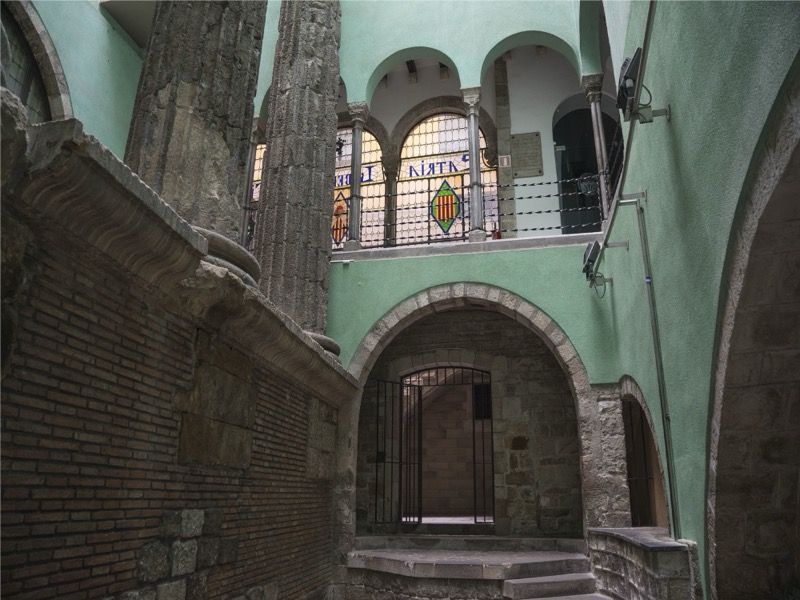
MUHBA Temple d’August
Table of contents: ()
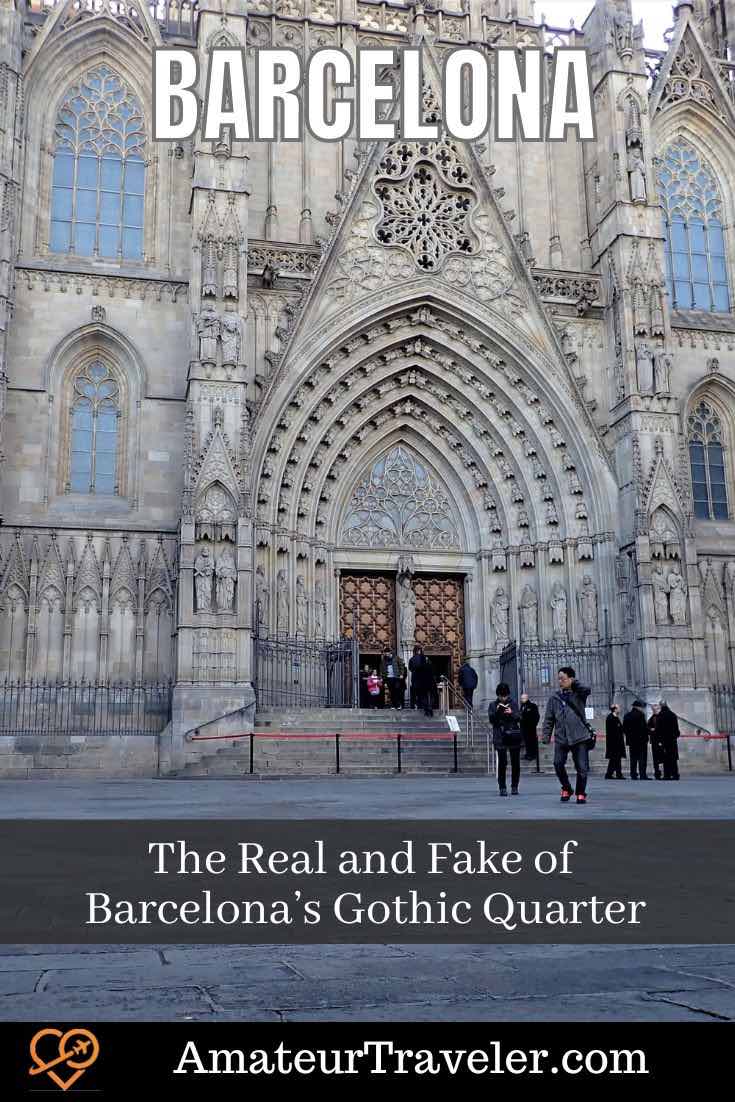
- A Brief Barcelona History
- The Fake and Real in Gothic Quarter Barcelona
- Barcelona Cathedral
- Casa Ardiaca City Archives
- Plaça del Rei and Barcelona History Museum MUHBA
- Roman Walls
- Barcelona Diocesan Museum
- Plaça Sant Felip Neri
- Museu Frederic Marès
- Pont del Bisbe
- MUHBA Temple d’August
- Basílica de Santa Maria del Pi
- MUHBA Porta de Mar
- Plaça dels Traginers
- Casa de la Ciutat de Barcelona (Town Hall)
A Brief Barcelona History
Iberian Barkeno
The first documented settlements in Barcelona are the Barkeno Iberian tribe with archaeological estimates dating to around 5000 BC.

The remains of the Roman town of Barcino
Roman Barcino Barcelona
The first substantial urbanization was by the Romans where what is today the Gothic Quarter formed an elongated octagonal walled city bounded by a seaport and farmland. The Roman Empire established a colony in 1BC, of about a thousand inhabitants, serving as a retirement home for soldiers of the Empire. The main Roman city in Spain was Tarraco (Tarragona) which served as the administrative capital for the whole Iberian Peninsula (Spain and Portugal) under Roman rule. Barcelo was an outlying colony.
Medieval Barcelona
The dynastic crown of Aragon covered the whole of Catalonia parts of southern France, and a Mediterranean empire that included the Balearic Islands, Sicily, Corsica, Sardinia, Malta, and southern Italy. One of the main residences of the courts of Aragon was located in the Gothic Quarter which made Barcelona an economic and political powerhouse during the 13th to 15th Centuries.
Barcelona under the Spanish Monarchy
The marriage of Ferdinand II of Aragon and Isabella I of Castile in 1469 united the two royal lines and united the many Iberian kingdoms into what is today modern-day Spain. Madrid became the center of political power and with the colonization of the South American continent, reduced the importance of Mediterranean trade in favor of Atlantic port cities. This was a very affluent period for Spain with the gold and food products such as chocolate coming from the South American colonies. However, the death of the childless king Carlos II de España led to the War of Spanish Succession from 1701 to 1714. The Catalonia region sided with the Habsburgs against the Bourbon Felipe V de España who won the war of succession and abolished Catalonia as an autonomous region and language.
Catalan Renaixença (Renaissance)
Renewal began in the mid-19th century with the arrival of the mechanized textile industry with mills being set up along prominent rivers such as the Llobregat. This was followed by the industrial revolution sweeping across Europe with Barcelona being populated by many factories in neighborhoods such as Sants, Gracia, and Poblenou. The 20th century started with widespread urban renewal throughout Barcelona city, with new a city-wide massive expansion called the Eixample District (Cheap farmland to build on!) which contains some of Barcelona’s most distinctive Catalan Modernism buildings. Prominent Catalan architects such as Antoni Gaudí, designed unique buildings like the Casa Milà/ La Pedrera, Casa Batlló, and the Sagrada Família church that are part of the nine UNESCO world heritage sites in Barcelona. This increased wealth funded urban renewal in the Gothic quarter with the demolition of some areas to build governmental palaces.
Spanish Civil War
From 1936 to 1939 Spain descended into civil war when General Francisco Franco forcibly took control of the country changing it from a democratically elected government to a dictatorship. Catalonia was one of the last strongholds to fall under his regime being aerial and naval bombarded by Italian and German forces, allied with General Franco. Spain did not participate in World War II, remaining neutral but favoring the Axis powers more than the Allied powers because of the assistance during the Spanish Civil War. Barcelona was one of the first cities to suffer the horror of indiscriminate aerial bombardment of the civilian population by the Italian Air Force. Dictatorship in Spain under General Franco lasted till 1975 when upon his death Spain transitioned back to an elected democracy.
The Fake and Real in Gothic Quarter Barcelona

Barcelona Santa Creu i Eulália Cathedral
Barcelona Cathedral
The inside of the cathedral is the original, but the outside is not. The Santa Creu i Eulália Cathedral is authentic Gothic architecture including the medical cloisters and both date from the 14th Century. However, the ornate gothic Façade with the rose window and spires are later edition from 1887 to 1890 built over the original nondescript medieval façade. Famous Barcelona architect Antoni Gaudí hated it and refused to enter the cathedral via the front entrance.
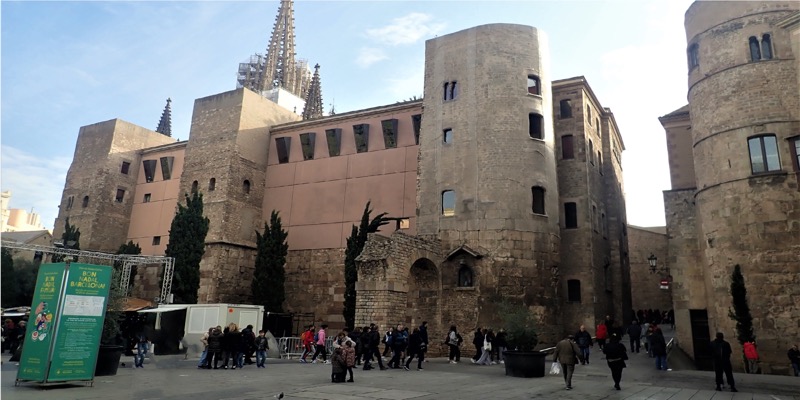
Casa Ardiaca city archives building
Casa Ardiaca City Archives
The city archives building Casa Ardiaca is a mix of fake and real. The ground floors are built into the original ruins of the Roman wall with the right round wall watch tower forming what was once, one of four Roman gates into the walled city. The two square towers are also part of the original 4th-century Roman Wall. The pink-colored building infill dates from the 12th century when this building was used as the archdeacon’s house. On the left of the gate towers, you can see the remains of the Roman aqueduct that is embedded in the tower. This is fake being a 1958 reconstruction of part of the original aqueduct that entered the city through the same place as this replica.

Plaça del Rei looking at Mirador del Rei Martí tower
Plaça del Rei and Barcelona History Museum MUHBA
The building that houses the Barcelona History Museum (Plaça del Rei) is mostly real and slightly fake. The museum is made of several medieval royal palaces.
Casa Padelles
Casa Padelles is a Gothic palace (originally built between 1497 and 1515) located at number 25, Carrer Mercader, in Barcelona. Due to the construction of the Via Laietana in the early 20th century cutting through medieval Barcelona, the building was disassembled in 1931 and relocated to the Plaça del Rei and is therefore fake (or at least reconstructed).
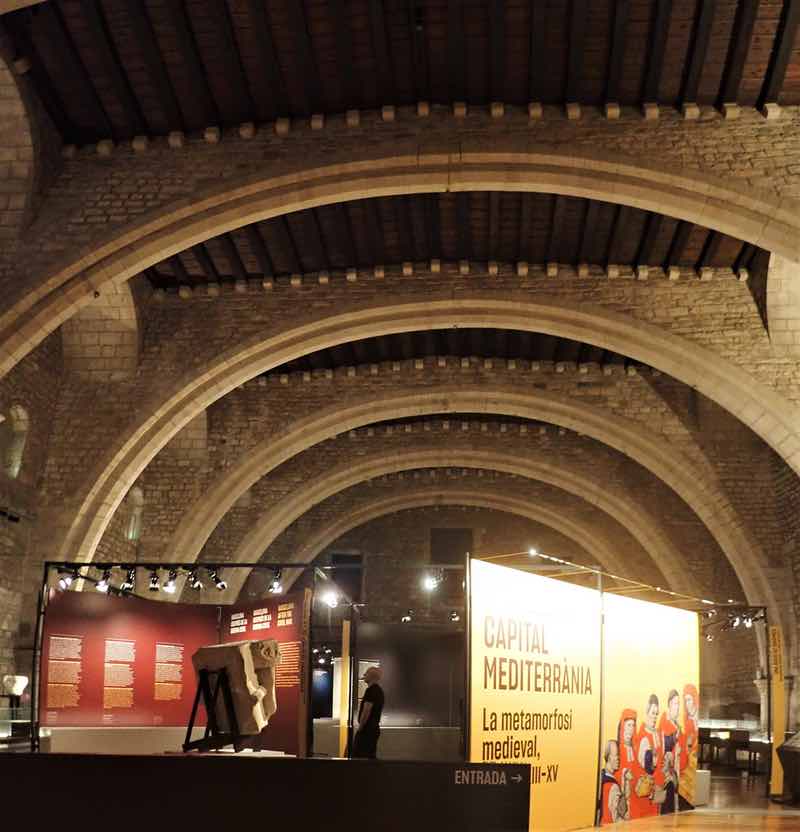
Saló del Tinell (Tinell Hall)
Palau Reial Major (Count’s Royal Palace)
This is a complex of buildings that were the residence of the Counts of Barcelona and Kings of Aragon. It can be described as three buildings:
- Saló del Tinell (Tinell Hall): built from 1359 to 1362 by King Peter.
- (Capella de Santa Àgueda) Palatine Chapel of Saint Agatha: built during the reign of King James II around 1302.
- (Palau de Lloctinent) Lloctinent Palace: built by the Catalan Generalitat under Charles V around 1549. The Royal palaces are built on the remains of the Roman city. In the basement of the MUHBA buildings (extending under Plaça del Rei) the remains of the Roman town of Barcino (Barcelona) were found and are preserved with a spectacular walkway route through the old streets, house ruins, bathhouses, and old city walls. The arcaded façade and tower seen from Plaça del Rei is called Mirador del Rei Martí and is Roman in origin with modernizations during the 14th Century (completed in 1555).
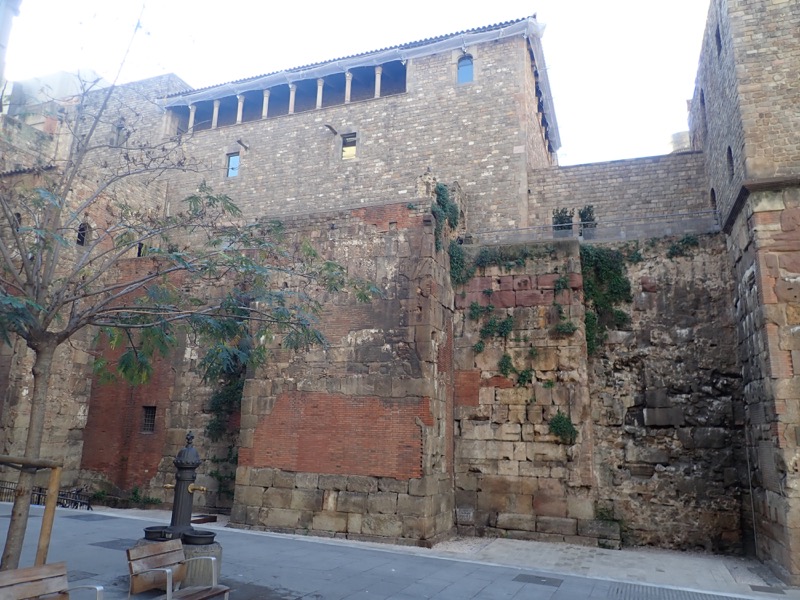
Plaça de Ramon Berenguer El Gran 4th Century Roman wall
Roman Walls
The Roman wall remains in Plaça de Ramon Berenguer El Gran and Carrer de la Tapineria. It is real. Barcino was founded in the time of Augustus and grew to be a large Colony of the Roman Empire. At the end of the 3rd century, Emperor Claudius decided to strengthen the primitive 1.3 km long Roman city wall in Barcelona following the outline of the earlier one with a thicker and taller wall containing 75 watchtowers.
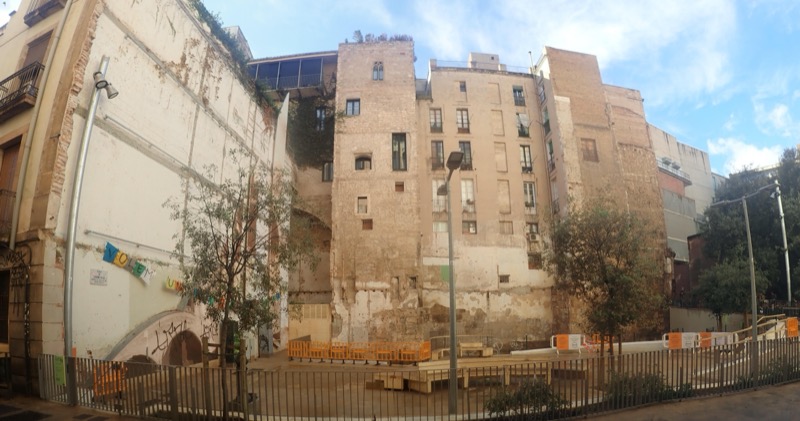
Carrer de la Tapineria Roman wall
The Roman wall remained around the former Roman colony for over a thousand years until King Jaime I de Aragón ordered a new wall to be built around the now much larger medieval city of Barcelona in the 13th century. The only remains of the 13th-century wall are a section in Avenida Parallel next to the Barcelona Maritime Museum and a section in Sant Antoni Market.
Barcelona Diocesan Museum
The Barcelona Diocesan Museum is both real and fake. Like Casa Adiaca to the right of the cathedral, this museum to the left of the cathedral is located in a historic building called Casa de la Pia Almoina which in itself was built in the 4th Century Roman wall. The building has been extensively remodeled to look like an authentic medieval Catalan house.

Church in 6. Plaça Sant Felip Neri with authentic 1938 Spanish Civil War bomb shrapnel damage
Plaça Sant Felip Neri
The Plaça Sant Felip Neri is very real. This square contains a baroque church called Oratori de Sant Felip Neri built between 1721 and 1752. During the Spanish Civil War, on 30th January 1938, Francoist forces were aerial bombing the city when munitions fell in the square killing 42 people, mostly children, who were trying to reach the shelter in the basement of the church. The façade of the church still bears the pitted shrapnel scars to this day. In one corner of the square is Casa del Gremi dels Sabaters, a shoe shop dating from 1565.
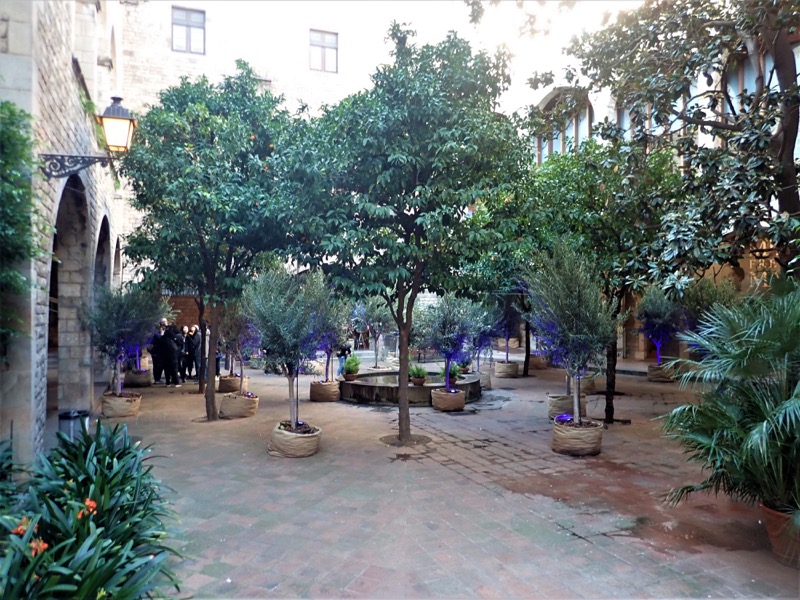
Courtyard of 7. Museu Frederic Marès
Museu Frederic Marès
The Museu Frederic Marès is real. Located in the Palace of the Counts of Barcelona the building is a medieval palace with an interior courtyard garden. Palatial buildings have stood on this site since the 10th century with the current building dating from 1550. The building retains its medieval palace layout with a series of small and large rooms containing the collections and personal works of the prominent Catalan artist and sculptor, Frederic Mares.
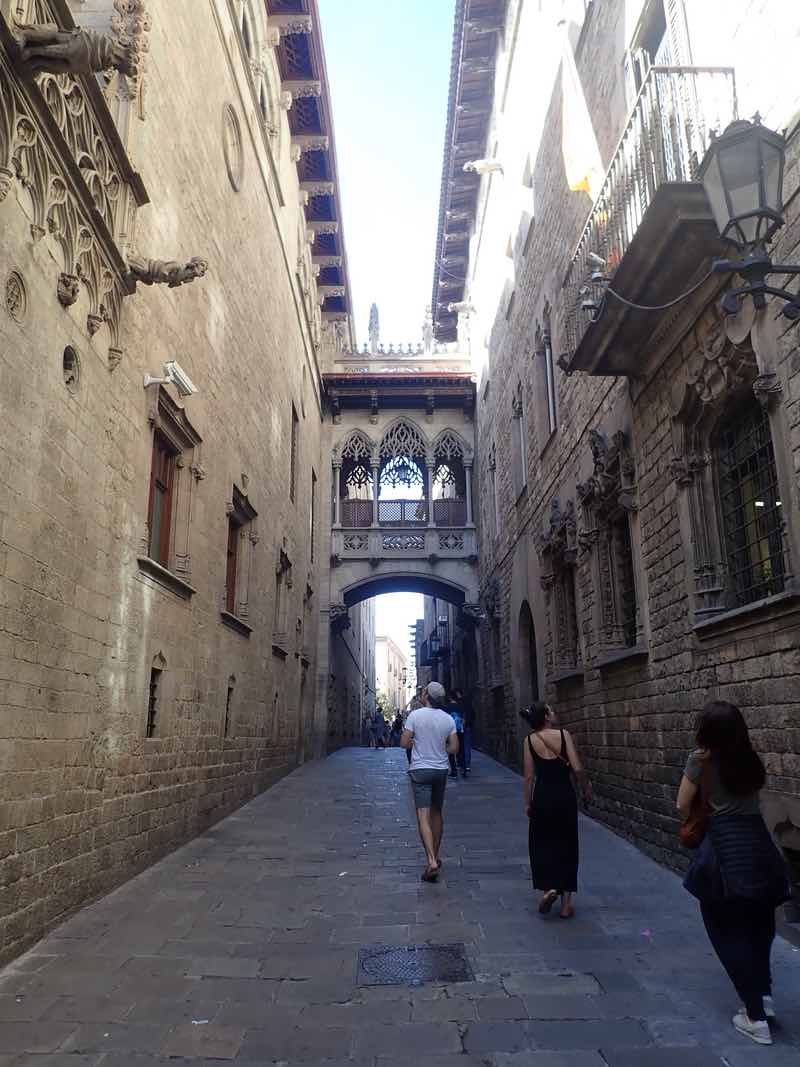
Pont del Bisbe
Pont del Bisbe
The Pont del Bisbe (bridge) is fake. Without a doubt, the most photographed sight in the gothic quarter is this medieval gothic-looking bridge over Carrer del Bisbe linking Casa dels Canonges with Palau de la Generalitat de Catalunya. The bridge has all the hallmarks of gothic architecture like the cathedral, (gargoyles, crests, pointed gothic spindly arches) with the alignment of the street allowing the sun to shine down it through the bridge producing an eerie, sometimes supernatural light.

Palau de la Generalitat
On appearance, you would date it from the 12th to 14th Century. However, it is a Neo-Gothic bridge constructed in the 1920s ahead of the Barcelona 1929 International Exhibition. Joan Rubió i Bellver was the Catalan architect who designed the bridge and a pupil (and collaborator) of Antoni Gaudí. Joan was heavily influenced by medieval Gothic buildings, and in his capacity as the official architect of the province of Barcelona, proposed a radical idea of tearing down all non-gothic buildings in the Gothic quarter and rebuilding them in the Catalan Gothic medieval style. His proposal was flatly rejected by the city council and this bridge is his snub to Barcelona.
Joan Rubió i Bellver’s copy of a cathedral rib-vaulted ceiling can be glimpsed at the base of the bridge. It features a central boss of a carved skull pierced by a dagger. The superstitious tale is that the architect added it to the decoration of the bridge after being snubbed by the city authorities and it’s imbued with a curse. If the dagger is removed from the skull, then Barcelona will be destroyed. It’s also rumored that the skull is not a stone replica but taken from human remains.

MUHBA Temple d’August
MUHBA Temple d’August
The MUHBA (Museu Historia de Barcelona) Temple d’August is real. Hidden away in the corner of Carrer del Paradís 10 in the center of the old Jewish Quarter, Barcelona (El call) is a wooden doorway leading into a small fake medieval courtyard typical of the gothic buildings of this area.
At the end of this courtyard is a door into an atrium that contains the remains of the Roman Temple of Augustus. This consists of four columns and a section of the plinth of the original 2000+-year-old Roman temple of Barcino dating from 1 BC. I was blown away when I found this hidden gem of authentic Roman ruins and best of all is that it is free to visit.
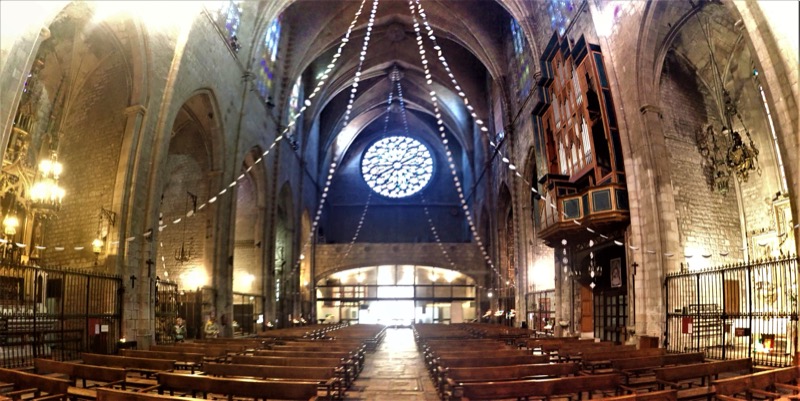
Basílica de Santa Maria del Pi
Basílica de Santa Maria del Pi
The Basílica de Santa Maria del Pi is real… mostly. The Catalan Gothic church has a single nave with side chapels. It was built from 1319 to 1391 in Plaça del Pi. The Cross vaulted ceiling allows one of the largest rose windows in Catalonia. The rose window is a copy of the original which was destroyed in the Spanish Civil War (1936 to 1939). This basilica has one of the tallest octagonal spires in Barcelona and can be climbed to the roof as part of a very good-value guided tour.

Views from the Octagonal Tower of Santa Maria del Pi
I recommend this basilica tour in preference to the Cathedral de Barcelona visit which today is oversubscribed with tourists and has a fake façade and spire.
MUHBA Porta de Mar
The MUHBA (Museu Historia de Barcelona) Porta de Mar is real. This is a Roman wall section containing the southern sea-facing sea gate. On the outside of the Roman wall was a public bathhouse for Roman citizens. A section of the baths and wall remains and can be viewed from a two-tier platform gallery. These Roman ruins are enclosed in a modern civic center that provides free access, albeit with limited hours.
Plaça dels Traginers
The Plaça dels Traginers is real. This square contains a corner of the original Roman walls on the sea-facing side with a circular watch tower.

Casa de la Ciutat de Barcelona (Town Hall)
Casa de la Ciutat de Barcelona (Town Hall)
The Casa de la Ciutat de Barcelona is fake outside, but real inside. In Plaça de Sant Jaume is a neo-classical palace with a typically French style façade. Within this building are a series of historic gothic governmental halls:
- Saló Carles Pi i Sunyer: A marble-lined semi-circular room with pew benches arranged around a central podium. The room is used for the plenary sessions for the 41 councilors of the city.
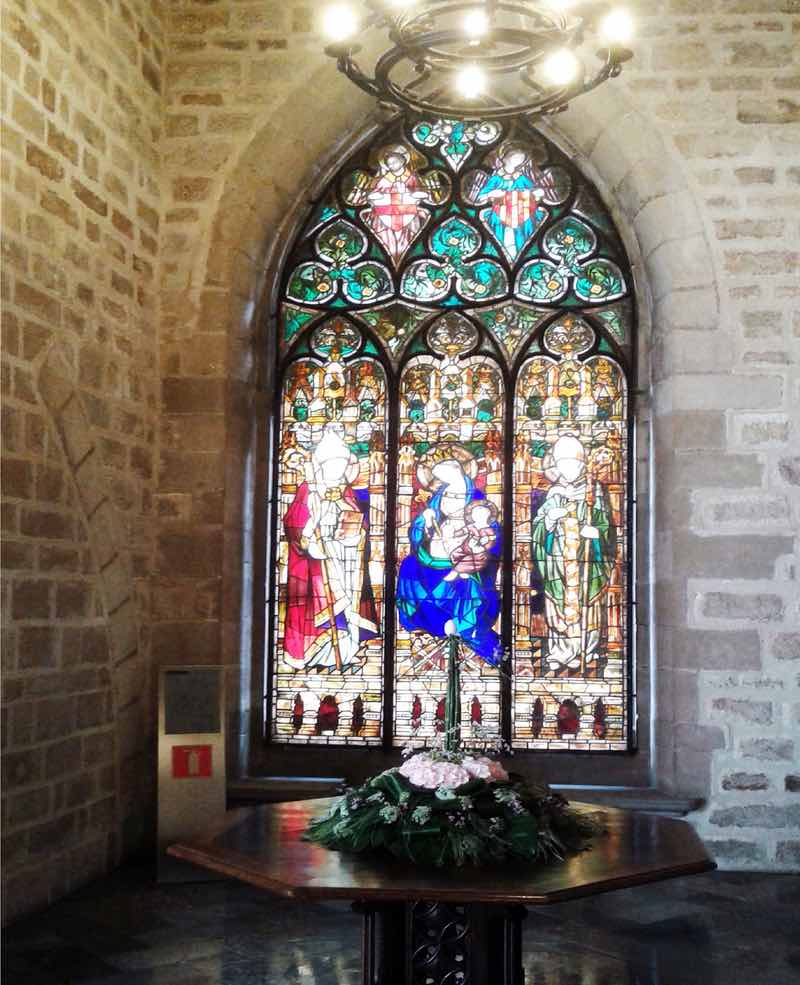
Saló de Cent hall of the 100 counts
- Saló de Cent: is a large rectangular plan hall for the 100 counts that ruled Catalonia from 1373 till 1714 (War of Spanish Succession). The hall was built by the master builder Pere Llobet in 1369. A stone located at the back of the room informs that King Pedro III de Aragón celebrated the first Council of the Hundred Counts. The hall has two semicircular arches spanning the room to support the wooden flat roof beam ceiling. Light entered through a large rosette supplemented with three smaller ones. The great hall underwent several renovations over time and its original appearance was modified. The bombardment of 1842 caused significant damage and the last reform dating from the early 20th century added the gothic-style chancel and the alabaster altarpiece.
- The fake ugly 1847 façade is a French-inspired monstrosity of boringness with statues of long-dead kings in alcoves but interior visits to the authentic gothic palaces are available on notable Catalan public holidays and sometimes at weekends.
I hope this overview of the fake and real monuments of the Gothic Quarter serves you when visiting this part of Barcelona. For more information on each individual attraction, you can read more at Barcelona Travel Hacks guide to the Gothic Quarter

 5 Free Attractions to Visit in Barcelona
5 Free Attractions to Visit in Barcelona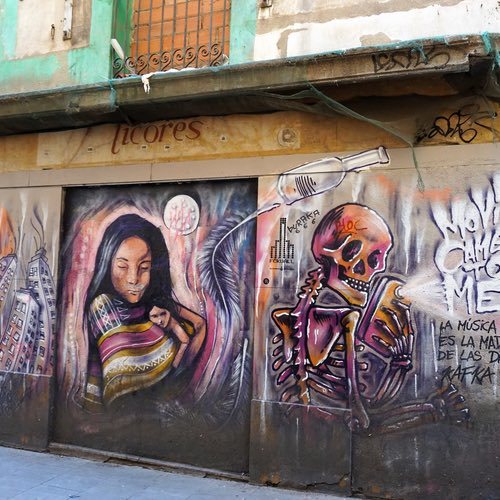 Touring El Raval in Barcelona
Touring El Raval in Barcelona Travel to Barcelona, Spain – Episode 122
Travel to Barcelona, Spain – Episode 122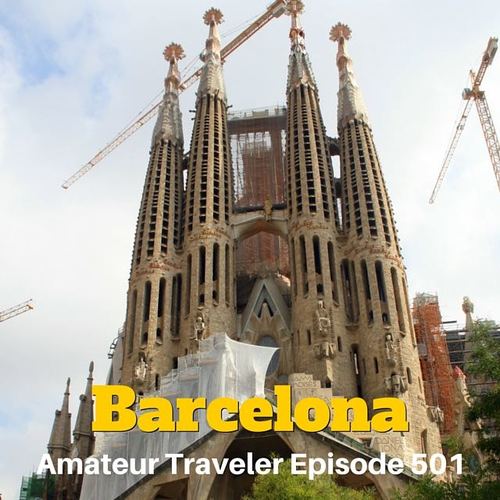 Travel to Barcelona, Spain – Episode 501
Travel to Barcelona, Spain – Episode 501
